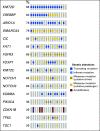Genomic Characterization of Upper-Tract Urothelial Carcinoma in Patients With Lynch Syndrome
- PMID: 30854504
- PMCID: PMC6404976
- DOI: 10.1200/PO.17.00143
Genomic Characterization of Upper-Tract Urothelial Carcinoma in Patients With Lynch Syndrome
Abstract
Purpose: Patients with Lynch syndrome (LS) have a significantly increased risk of developing upper-tract urothelial carcinoma (UTUC). Here, we sought to identify differences in the patterns of mutational changes in LS-associated versus sporadic UTUCs.
Patients and methods: We performed targeted sequencing of 17 UTUCs from patients with documented LS-associated germline mutations (LS-UTUCs) using the Memorial Sloan Kettering Integrated Molecular Profiling of Actionable Cancer Targets targeted exon capture assay and compared the results with those from a recently characterized cohort of 82 patients with sporadic UTUC.
Results: Patients with LS-UTUC were significantly younger, had had less exposure to tobacco, and more often presented with a ureteral primary site compared with patients with sporadic UTUC. The median number of mutations per tumor was significantly greater in LS-UTUC tumors than in tumors from the sporadic cohort (58; interquartile range [IQR], 47-101 v 6; IQR, 4-10; P < .001), as was the MSIsensor score (median, 25.1; IQR, 17.9-31.2 v 0.03; IQR, 0-0.44; P < .001). Differences in the genetic landscape were observed between sporadic and LS-associated tumors. Alterations in KMT2D, CREBBP, or ARID1A or in DNA damage response and repair genes were present at a significantly higher frequency in LS-UTUC. CIC, NOTCH1, NOTCH3, RB1, and CDKN1B alterations were almost exclusive to LS-UTUC. Although FGFR3 mutations were identified in both cohorts, the R248C hotspot mutation was highly enriched in LS-UTUC.
Conclusion: LSand sporadic UTUCs have overlapping but distinct genetic signatures. LS-UTUC is associated with hypermutation and a significantly higher prevalence of FGFR3 R248C mutation. Prospective molecular characterization of patients to identify those with LS-UTUC may help guide treatment.
Conflict of interest statement
Timothy F. Donahue
No relationship to disclose
Aditya Bagrodia
No relationship to disclose
François Audenet
No relationship to disclose
Mark T.A. Donoghue
No relationship to disclose
Eugene K. Cha
No relationship to disclose
John P. Sfakianos
Dahlia Sperling
Hikmat Al-Ahmadie
Mark Clendenning
No relationship to disclose
Christophe Rosty
No relationship to disclose
Daniel D. Buchanan
No relationship to disclose
Mark Jenkins
No relationship to disclose
John Hopper
No relationship to disclose
Ingrid Winship
No relationship to disclose
Allyson S. Templeton
No relationship to disclose
Michael F. Walsh
No relationship to disclose
Zsofia K. Stadler
Gopa Iyer
No relationship to disclose
Barry Taylor
No relationship to disclose
Jonathan Coleman
No relationship to disclose
Noralane M. Lindor
David B. Solit
Bernard H. Bochner
Figures






Similar articles
-
Genomic Characterization of Upper Tract Urothelial Carcinoma.Eur Urol. 2015 Dec;68(6):970-7. doi: 10.1016/j.eururo.2015.07.039. Epub 2015 Aug 14. Eur Urol. 2015. PMID: 26278805 Free PMC article.
-
Identification of Germline Mutations in Upper Tract Urothelial Carcinoma With Suspected Lynch Syndrome.Front Oncol. 2022 Mar 16;12:774202. doi: 10.3389/fonc.2022.774202. eCollection 2022. Front Oncol. 2022. PMID: 35372080 Free PMC article.
-
Clonal Relatedness and Mutational Differences between Upper Tract and Bladder Urothelial Carcinoma.Clin Cancer Res. 2019 Feb 1;25(3):967-976. doi: 10.1158/1078-0432.CCR-18-2039. Epub 2018 Oct 23. Clin Cancer Res. 2019. PMID: 30352907 Free PMC article.
-
Molecular intricacies of upper tract urothelial carcinoma and their relevance for therapy considerations.Curr Opin Urol. 2022 Jan 1;32(1):48-53. doi: 10.1097/MOU.0000000000000943. Curr Opin Urol. 2022. PMID: 34772864 Review.
-
Lynch syndrome and exposure to aristolochic acid in upper-tract urothelial carcinoma: its clinical impact?Transl Androl Urol. 2016 Oct;5(5):648-654. doi: 10.21037/tau.2016.03.18. Transl Androl Urol. 2016. PMID: 27785421 Free PMC article. Review.
Cited by
-
Upper Tract Urinary Carcinoma: A Unique Immuno-Molecular Entity and a Clinical Challenge in the Current Therapeutic Scenario.Technol Cancer Res Treat. 2023 Jan-Dec;22:15330338231159753. doi: 10.1177/15330338231159753. Technol Cancer Res Treat. 2023. PMID: 36855829 Free PMC article. Review.
-
Unique genomic and neoepitope landscapes across tumors: a study across time, tissues, and space within a single lynch syndrome patient.Sci Rep. 2020 Jul 22;10(1):12190. doi: 10.1038/s41598-020-68939-7. Sci Rep. 2020. PMID: 32699259 Free PMC article.
-
Validation of computational determination of microsatellite status using whole exome sequencing data from colorectal cancer patients.BMC Cancer. 2019 Oct 21;19(1):971. doi: 10.1186/s12885-019-6227-7. BMC Cancer. 2019. PMID: 31638937 Free PMC article.
-
Relative Risk of Bladder and Kidney Cancer in Lynch Syndrome: Systematic Review and Meta-Analysis.Cancers (Basel). 2023 Jan 13;15(2):506. doi: 10.3390/cancers15020506. Cancers (Basel). 2023. PMID: 36672455 Free PMC article. Review.
-
Upper Tract Urothelial Carcinoma: A Rare Malignancy with Distinct Immuno-Genomic Features in the Era of Precision-Based Therapies.Biomedicines. 2023 Jun 21;11(7):1775. doi: 10.3390/biomedicines11071775. Biomedicines. 2023. PMID: 37509415 Free PMC article. Review.
References
-
- Watson P, Lynch HT. Extracolonic cancer in hereditary nonpolyposis colorectal cancer. Cancer. 1993;71:677–685. - PubMed
-
- Lynch HT, Smyrk TC, Watson P, et al. Genetics, natural history, tumor spectrum, and pathology of hereditary nonpolyposis colorectal cancer: An updated review. Gastroenterology. 1993;104:1535–1549. - PubMed
-
- Watson P, Riley B. The tumor spectrum in the Lynch syndrome. Fam Cancer. 2005;4:245–248. - PubMed
-
- Watson P, Lynch HT. The tumor spectrum in HNPCC. Anticancer Res. 1994;14:1635–1639. - PubMed
-
- Sijmons RH, Kiemeney LA, Witjes JA, et al. Urinary tract cancer and hereditary nonpolyposis colorectal cancer: Risks and screening options. J Urol. 1998;160:466–470. - PubMed
Grants and funding
LinkOut - more resources
Full Text Sources
Molecular Biology Databases
Miscellaneous

